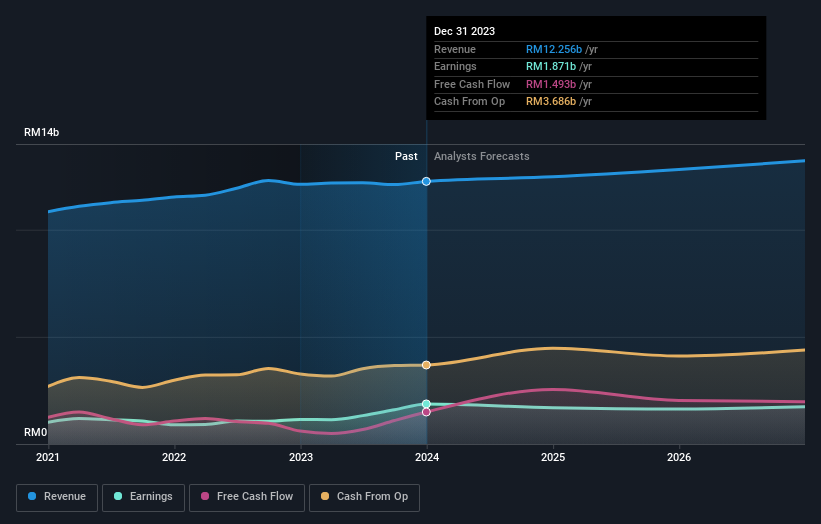Stock Analysis
Telekom Malaysia Berhad's (KLSE:TM) high institutional ownership speaks for itself as stock continues to impress, up 9.4% over last week

Key Insights
- Significantly high institutional ownership implies Telekom Malaysia Berhad's stock price is sensitive to their trading actions
- The top 3 shareholders own 54% of the company
- Analyst forecasts along with ownership data serve to give a strong idea about prospects for a business
To get a sense of who is truly in control of Telekom Malaysia Berhad (KLSE:TM), it is important to understand the ownership structure of the business. And the group that holds the biggest piece of the pie are institutions with 43% ownership. In other words, the group stands to gain the most (or lose the most) from their investment into the company.
And last week, institutional investors ended up benefitting the most after the company hit RM25b in market cap. One-year return to shareholders is currently 36% and last week’s gain was the icing on the cake.
Let's delve deeper into each type of owner of Telekom Malaysia Berhad, beginning with the chart below.
View our latest analysis for Telekom Malaysia Berhad

What Does The Institutional Ownership Tell Us About Telekom Malaysia Berhad?
Many institutions measure their performance against an index that approximates the local market. So they usually pay more attention to companies that are included in major indices.
Telekom Malaysia Berhad already has institutions on the share registry. Indeed, they own a respectable stake in the company. This implies the analysts working for those institutions have looked at the stock and they like it. But just like anyone else, they could be wrong. If multiple institutions change their view on a stock at the same time, you could see the share price drop fast. It's therefore worth looking at Telekom Malaysia Berhad's earnings history below. Of course, the future is what really matters.

We note that hedge funds don't have a meaningful investment in Telekom Malaysia Berhad. Looking at our data, we can see that the largest shareholder is Khazanah Nasional Berhad with 20% of shares outstanding. Meanwhile, the second and third largest shareholders, hold 17% and 17%, of the shares outstanding, respectively.
To make our study more interesting, we found that the top 3 shareholders have a majority ownership in the company, meaning that they are powerful enough to influence the decisions of the company.
Researching institutional ownership is a good way to gauge and filter a stock's expected performance. The same can be achieved by studying analyst sentiments. There are plenty of analysts covering the stock, so it might be worth seeing what they are forecasting, too.
Insider Ownership Of Telekom Malaysia Berhad
The definition of company insiders can be subjective and does vary between jurisdictions. Our data reflects individual insiders, capturing board members at the very least. Management ultimately answers to the board. However, it is not uncommon for managers to be executive board members, especially if they are a founder or the CEO.
I generally consider insider ownership to be a good thing. However, on some occasions it makes it more difficult for other shareholders to hold the board accountable for decisions.
Our data suggests that insiders own under 1% of Telekom Malaysia Berhad in their own names. It is a pretty big company, so it would be possible for board members to own a meaningful interest in the company, without owning much of a proportional interest. In this case, they own around RM177k worth of shares (at current prices). It is good to see board members owning shares, but it might be worth checking if those insiders have been buying.
General Public Ownership
With a 20% ownership, the general public, mostly comprising of individual investors, have some degree of sway over Telekom Malaysia Berhad. This size of ownership, while considerable, may not be enough to change company policy if the decision is not in sync with other large shareholders.
Next Steps:
I find it very interesting to look at who exactly owns a company. But to truly gain insight, we need to consider other information, too. Consider for instance, the ever-present spectre of investment risk. We've identified 2 warning signs with Telekom Malaysia Berhad (at least 1 which makes us a bit uncomfortable) , and understanding them should be part of your investment process.
If you would prefer discover what analysts are predicting in terms of future growth, do not miss this free report on analyst forecasts.
NB: Figures in this article are calculated using data from the last twelve months, which refer to the 12-month period ending on the last date of the month the financial statement is dated. This may not be consistent with full year annual report figures.
Valuation is complex, but we're helping make it simple.
Find out whether Telekom Malaysia Berhad is potentially over or undervalued by checking out our comprehensive analysis, which includes fair value estimates, risks and warnings, dividends, insider transactions and financial health.
View the Free AnalysisHave feedback on this article? Concerned about the content? Get in touch with us directly. Alternatively, email editorial-team (at) simplywallst.com.
This article by Simply Wall St is general in nature. We provide commentary based on historical data and analyst forecasts only using an unbiased methodology and our articles are not intended to be financial advice. It does not constitute a recommendation to buy or sell any stock, and does not take account of your objectives, or your financial situation. We aim to bring you long-term focused analysis driven by fundamental data. Note that our analysis may not factor in the latest price-sensitive company announcements or qualitative material. Simply Wall St has no position in any stocks mentioned.
About KLSE:TM
Telekom Malaysia Berhad
Telekom Malaysia Berhad engages in the establishment, maintenance, and provision of telecommunications and related services in Malaysia and internationally.
Outstanding track record, undervalued and pays a dividend.

